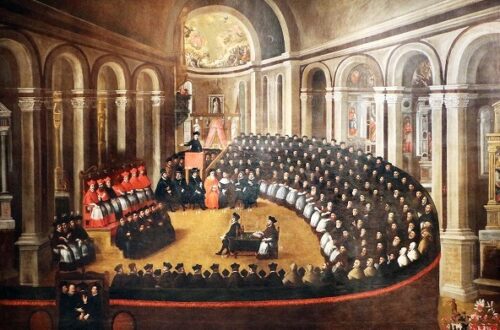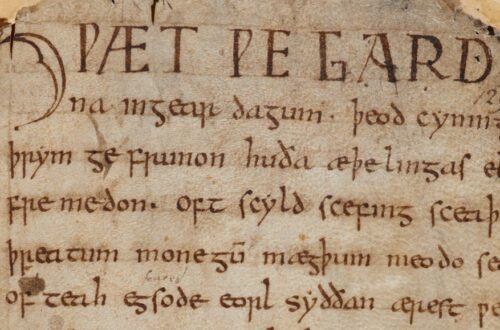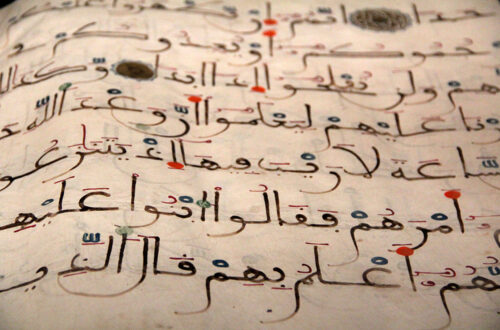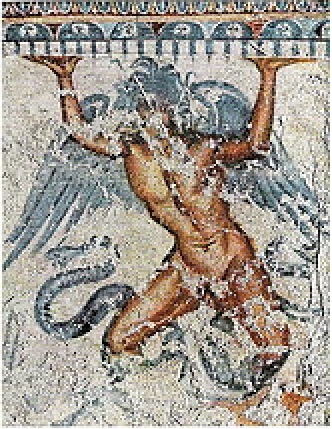
Velikovsky on Trial
Preface
The works of the Russian-Israeli-American psychoanalyst Immanuel Velikovsky (1895-1979) caused some turmoil and controversy in America in the fifties of the 20th century. They became known in Germany for a short time, but were unsuccessful there and soon forgotten. Catastrophism and chronology revision on a biblical basis were not a topic of discussion then.
There was a second attempt from 1978/79 onwards triggered by Christoph Marx (Basel), who translated some of Velikovsky’s books into German (“Earth in Upheaval”, “Peoples of the Sea”, etc.). This time Velikovsky found supporters in Germany who took up his theory and promoted it. In general, however, the rejection by academics was predominant, while the Velikovsky group gradually developed into a wide-ranging movement. Its topics are historical analysis and chronological criticism. The most important representatives gradually moved away from Velikovsky’s core theses at an early stage and refuted his religious theories. So did Heinsohn in 1987 (2006, p. 552). Finally only the initial spark triggered by Velikovsky remained, i.e. questioning chronology.
In a critical examination of Velikovsky, 2005, I expressed my fundamental concerns about applying the psychoanalytic method to the history of mankind as a whole. I rejected his manner to link cosmic events to biblical stories, such as quotation of a ten-day recess of the sun (Hezekiah-Isaiah), which Velikovsky interpreted as an account of a cosmic upheaval in the “night of March 23, 687 BC”. Yet according to the Bible text nothing catastrophic appeared or happened.
The group of Velikovsky’s followers in England grew all the time. Since 1975 it got bundled in a “non-profitmaking organization”. Based on Velikovsky’s theories, it maintains his legacy albeit profoundly revised and progressing far beyond Velikovsky’s results. The idea of catastrophism as well as a new cosmic model of the electric universe and an abridged chronology took root. This is the SIS = Society for Interdisciplinary Studies, which has members worldwide and publishes the latest status of its research in meetings every six months and in booklets every four months (C&C Review = Chronology and Catastrophism Review). Velikovsky’s ideas have priority there and invite lively discussions.
In this sense of open research and harsh criticism, three essays have appeared in the C&C Review in 2019 / 2020 that expose Velikovsky’s fundamental error and deprive him of his oldest assumption, namely that the Exodus report of the Bible goes back to a series of cosmic upheavals that can be dated and historically recognized.
The three essays are:
Mills, Donald Keith (2019): Rockenbach Falls – and King Typhon Tumbles (C&C Review 2019, 3)
Sluijs, Marinus Anthony van der (2020): Trials on the Trails of Typhon and the Exodus, Part 1 and 2 (C&C Review 2020, 2 and 3).
I recommend reading all three, here I will give only a brief consideration that is intended to underline the importance of these articles.
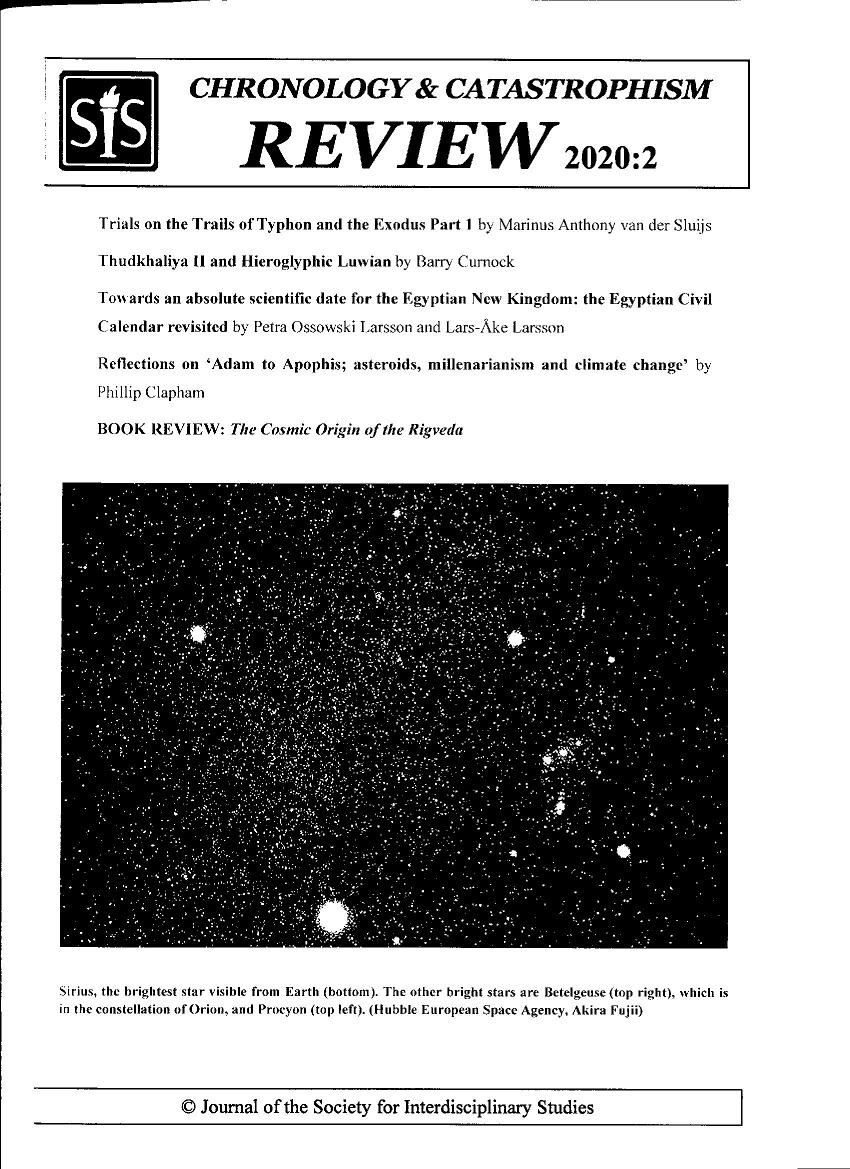
Source Studies: Velikovsky and the Holy Scriptures
Velikovsky propounded (in “Worlds in Collision”, 1950) a connection between a comet and catastrophic events at the time of the biblical Exodus. He refers to several writers of the 16/17th century, such as Abraham Rockenbach (1536-1611), German philologist, editor of an astronomical work “De Cometis” (1602), although its sources are rather uncertain and partly unknown, as Donald Keith Mills writes (C&C Review 2019,3).
Marinus Anthony van der Sluijs (C&C Review 2020.3) continued and deepened this thought. Both authors quote Hardouin’s commentary on Pliny and Radlof’s important work on catastrophism (1823).
Result: The written sources as used by Velikovsky don’t speak of causal connection between comets and catastrophes.
Thus, Velikovsky’s theory becomes unsustainable.
A causal connection between mythical reports of unusual observations of shining spheres or new stars and the devastation inflicted on the Egyptians or the rescue of the Hebrews, as thought by authors of the early Baroque (above all Abraham Rockenbach), is without any foothold in earlier literature. The merging of one of the shepherd kings of Egypt (Hyksos), called Typhon, and a cosmic destroyer of the same name, as Velikovsky assumes, is established by Rockenbach only on chronological standards.
While Velikovsky inferred from the use of mythical texts that a comet or even planets (Venus and Mars) could have triggered corresponding destructions, the ancient texts speak neither of a comet (but of a ball of fire) nor of cosmic upheavals.
In addition some quotations:
In Pliny 2, 49, Typhon is a cyclone (hurricane), in any case clearly an aerial phenomenon, not a comet. Typhon and comet are brought together in Pliny 2, 22 (“On Comets”), where comets are understood to be quite common as newly formed stars with hair (coma). The catalog lists comets according to the appearance of these stars (with beards or horse mane, etc.) based on Aristotle. Such a comet can be visible for 7 to 180 days, it can be an omen of misfortune, but it cannot have a devastating effect on earth. Sure, there was also a terrible fireball seen in Egypt and Ethiopia to which the then king Typhon gave his name. The other writers built on this reference of Pliny and especially on Plutarch. Velikovsky elaborates (p. 110) that it was not only Abraham Rockenbach who sets the appearance of the comet Typhon at the same time as the Israelites’ Exodus from Egypt. Samuel Bochart (17th century, “Hierozoicon”) also equates Typhon’s flight with the Exodus from Egypt. Since Typhon was a comet according to Pliny and others, Samuel Bochart had come very close to the conclusions Velikovsky came to in a different way.
Velikovsky quotes (p. 111, note 4), “that some here mix Typhon with the Jewish legends”. Names like Campester or Servius are mentioned as sources, but their writings are no longer extant. Rockenbach probably resorted to them.
But even without Campester’s dire prognosis, Velikovsky had a very impressive and simply inexhaustible array of references to Typhon and its devastating effect on the world: almost every Greek writer referred to it. Since Typhon was by its true nature supposed to be a comet, as Pliny and others explain, all references to the calamity caused by it are to be understood as descriptions of natural disasters in which the earth and the comet were involved.
In doing so, Velikovsky creates a parallel for the interpretation of the biblical plagues and events during the exodus of the Jewish people from the land of Egypt as if they were caused by the comet Typhon. However, the sources really do not pretend any connection. And, by the way, such a cosmological interpretation of the Bible text has no real base.
Velikovsky explains: The comet’s head didn’t crash into the earth, but exchanged violent electrical charges with it. – Very fancyful but the texts quoted give no clue to it.
Johann Funck was (according to Sluijs, part 1, p.9) around 1550 the first who set the biblical story in chronological relation to classical historiography for Egypt, based on Manetho and Diodor and the Berossus invented by Nanni. (Funck built on Copernicus, see also Topper, Jahrkreuz p. 215).
Rockenbach used this scheme. He did not establish a causal connection between the appearance of the comet and the natural events of that time, he was only concerned with dating this on a timescale.

Due to the chronology that emerged in this way, Typhon as King of Egypt was equated in time with the destruction caused by the comet Typhon (Pliny, Natural History 2, 22), which enabled Jacob Milich to take the next step. At this point it is likely that Velikovsky misunderstood his sources and mingled the chronological work of the 16th century with classic historiography. The common equation of gods, giants and humans turned into catastrophism in the unfounded view that a comet could have been responsible for the Exodus event. By citing “old sources” for this, Velikovsky overlooked the fact that these were largely written in the 16th century and later.
The two above-mentioned articles are not only strong arguments against Velikovsky’s way of forming his theory, but also enlightening on the widespread fear of comets, which only has a literary background.
Fear of Comets
The pronounced fear of comets begins with J. Grasser, Basel 1618, “About the Shocking Comets …” – a book that contributed to the systematic spread of fear. Before that, authors like Pliny had realized that comets occur regularly or frequently and have no direct effect on earth. In many cases they are viewed as indicators of bad luck.
Not always, though: The deification of Caesar after his murder, indicated by a comet, was understood quite differently by Augustus who had his temple built, namely as a heavenly reward for his foundation of games. The idea of a general destructive effect of comets was remote.
This also applies to the comet on the Bayeux Tapestry indicating the Normans’ victory over the Anglo-Saxons. Even the star, which is described shining for the birth of Jesus, was sometimes interpreted as a comet, in this case a lucky sign heralding the birth of a king.
In today’s interpretation, a distinction is seldom made between signs and causes that might be induced by a comet. The sign visible in the sky can be evaluated astrologically, primarily to predict the weather (since the Chaldeans), while this luminous appearance does not cause catastrophic happenings. Such an opinion only became predominant from the end of the 17th century, and then lasted quite a long time, with simple people repeating this until today.
See the excellent comments by Victor Stegemann in Bächthold-Stäubli, article Komet, also quoted by Sluijs. In the same sense, Carl Meyer occasionally says the same: Fear of comets was not a predominant characteristic prior to the modern era; one limited oneself to understand it as a hint from God.
As is now made clear by the essays of Mills and Sluijs, Velikovsky’s interpretation of celestial signs such as comets or ‘planetary encounters’ of Mars and Venus to be a cause for worldwide catastrophes is wrong because drawn from literature with blurred tradition.
Cosmic Disasters
In a broader sense it can be affirmed (with Leroy Ellenberger and Phil Burns):
From the legends we can perhaps figure out how people in prehistoric times made the cosmos comprehensible, but hardly how the cosmos behaved at that time. Mythology and geophysics are only compatible in a few places. Without textual criticism, the evaluation of old reports is worthless anyway, and even more so when it has no geophysical background.
And further: planets got their legendary god names by no means uniform but rather arbitrarily. If Venus in Greek myth is supposed to have sprung from the head of Jupiter, this doesn’t allow for any kind of geophysikal interpretation of the kind Velikovsky proposes. The idea is simply arbitrary.
In this sense, for example, the frequently cited book by Santillana and Dechent should be branded as a chilling example.
By the way: Velikovsky is by no means as original as was claimed, but rather drew on his predecessors from the 19th century such as Radlof and Donnelly, and these, too, were based on literature that rather belongs to the Renaissance and Baroque. This need not be wrong, yet it partly shows the Christian-Jewish origin, in other words: the religious fundamentals of this approach.
What remains is Velikovsky’s courageous overthrow of the completely ingenuous Egyptian chronology. This breakthrough in the matter of retro-calculation has initiated our relatively young movement of critical chronology. The connection to catastrophism, which is of course very close, was made by Velikovsky. And it is precisely this relationship that the (mostly English-speaking) critics of Velikovski’s interpretation are concerned with. After 1950 this was summarized under the controversial term “Velikovsky Affair”, whereby the difference between mythical and scientific thought became clear.
Marinus Anthony van der Sluijs dealt with the subject in detail on his website “mythopedia” since 2002.
In terms of the catastrophic interpretation of the mythical texts, the successors overlook the fact that precisely the reorganization of the chronology, which partly is founded on Velikovsky, first requires a reorganization of the texts. The terms “before” and “after” concerning the sequence of the traditions and sources must be established before conclusions can be drawn from it. Let me give you an example: If Velikovsky quotes the Latin author Varro extracted from Augustin’s “Civitas Dei”, and it now turns out that Augustin lived about a generation before Luther, then Varro must also be in that same time bracket. What does this mean for the legendary cosmic events? They are floating aloof in a time universe.
Now one more important criticism that Ellenberger (p. 20) brought forward: According to Velikovsky (section Temples and Obelisks, in “Worlds in Collision”) temples were built in such a way that they greeted the rising sun, and if later the orientation no longer corresponded to it, he took it as a sure indication of a shift in the earth’s axis. This might also be deduced from relocated new buildings of this temple, for which Velikovsky cites the findings of Lockyer, Nissen, and Penrose (the latter for Greek temples). It would be more plausible if these temples were oriented towards the rising of stars and that their displacement was caused by precession, which Velikovsky never questioned.
The temples could also be aligned with sightings at certain days in the solar year, as I found in our Romanesque church windows. A shift would then be understood as a jump of date in the calendar (Topper 2006).
References
Bächtold-Stäubli, Hanns (1927-1942): Handwörterbuch des deutschen Aberglaubens (I-X, Berlin and Leipzig)
Ellenberger, Leroy C. (1995): An Antidote to Velikovskian Delusions (in SKEPTIC Vol. 3 No. 4 (c.leroy@rocketmail.com)
Grafton, Anthony (1990): Forgers and Critics (Princeton, USA)
Heinsohn, Gunnar (2006): „Kein König David?“ in: Zeitensprünge 3/2006, S. 551-559 (Mantis, Gräfelfing b. München)Meyer, Carl (1884): Der Aberglaube des Mittelalters und der nachfolgenden Jahrhunderte (Lucerne / reprint Fourier, Wiesbaden 2003)
Mills, Donald Keith (2019): Rockenbach Falls – and King Typhon Tumbles (C&C Review 2019.3).
Radlof, Johann Gottlieb (1823): Zertrümmerung der großen Planeten Hesperus und Phaeton (Berlin)
Santillana, G. de & H. von Dechend (1969): Hamlet’s Mill (Boston)
Sluijs, Marinus Anthony van der (2020): Trials on the Trails of Typhon and the Exodus, Part 2 (C&C Review 2020,3)
Topper, Uwe (2006): Kalendersprung (Tübingen)
Topper, Uwe (2016): The Solar Year Cross (Tübingen) English summary here
Topper, Uwe (2005): Velikovsky and the Forgotten Catastrophy
Velikovsky (1950): Worlds in Collision (German translation Stuttgart 1978) – (1955): Earth in Upheaval (German translation by Christoph Marx. Frankfurt/Main: Umschau-Verlag, 1980)
Uwe Topper, Berlin 2021 (revised Febr. 28, 2021)


